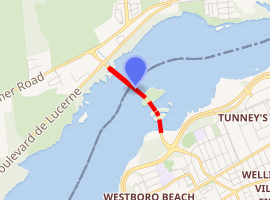Champlain Bridge, Ottawa
The Champlain Bridge (French: Pont Champlain) crosses the Ottawa River about 5 km (3.1 mi) west of Parliament Hill, joining the communities of Ottawa, Ontario and Gatineau, Quebec. It is the westernmost link between the two cities.
Champlain Bridge Pont Champlain | |
|---|---|
Champlain Bridge over the Ottawa River | |
| Coordinates | 45°24′35″N 75°45′34″W |
| Carries | 3 lanes connecting |
| Crosses | Ottawa River |
| Locale | Ottawa, Ontario |
| Owner | Government of Canada |
| Maintained by | National Capital Commission[1] |
| Characteristics | |
| Design | concrete girder bridge |
| Total length | 1.1 km (0.68 mi) |
| Width | 3 lanes connecting Place Samuel de Champlain and Island Park Drive, bicycle traffic |
| Clearance above | 2.7 metres (8.9 ft) |
| Clearance below | 3 metres (9.8 ft) |
| History | |
| Construction end | 1928 |
| Opened | 1924, 1928 |

| |
It was originally built between 1924 and 1928 by the Federal District Commission, the predecessor to the National Capital Commission (NCC), and the NCC continues to maintain the bridge. The bridge consists of 4 spans and crosses Riopelle, Cunningham and Bate Islands in the Ottawa River. The total length of the bridge is 1.1 km (0.68 mi), making it the longest bridge spanning the Ottawa River.
On the Ontario side, it is a continuation of Island Park Drive and is also connected to the Sir John A. Macdonald Parkway. It connects to Aylmer Road on the Quebec side.
A third reversible lane was added when the bridge was rebuilt in 2002, which is a high-occupancy vehicle lane used for crossings in the direction of peak traffic.[1]
The bridge was named after Samuel de Champlain who is associated with the portage around the rapids in this section of the river. The short access roadway on the Aylmer side of the bridge is called Place Samuel de Champlain.
Reference
- "Interprovincial bridges in the National Capital Region". National Capital Commission. Government of Canada. Retrieved July 15, 2020.